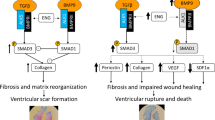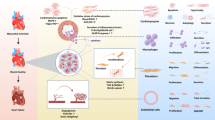Abstract
Cardiac rupture is a fatal complication of myocardial infarction (MI); however, its underlying molecular mechanisms are not fully understood. This study investigated the role of tissue inhibitor of metalloproteinase-3 (TIMP-3)/matrix metalloproteinase (MMP)/epidermal growth factor (EGF)/transforming growth factor (TGF)-β1 pathway in infarct healing and effects of cetuximab on cardiac rupture after MI. Induction of MI was achieved by left coronary artery ligation in wild-type (WT) and TIMP-3−/− mice. TIMP-3 deficiency resulted in a fourfold increase in cardiac rupture and 50% decrease in survival after MI. Hydroxyproline content, collagen synthesis and myofibroblast cell number in the infarct region, and the force required to induce rupture of the infarct scar were significantly decreased, while MMP activity was increased in TIMP-3−/− mice. EGF proteins were increased by threefold in TIMP-3−/− mice following MI, while TGF-β1 mRNA levels were decreased by 68%. Cell proliferation of cultured adult cardiac myofibroblasts was significantly decreased in TIMP-3−/− compared to WT myofibroblasts. EGF treatment significantly decreased collagen synthesis and TGF-β1 expression. Conversely, TGF-β1 treatment increased collagen synthesis in cardiac myofibroblasts. Treatment with cetuximab significantly decreased the incidence of cardiac rupture and improved survival post-MI in TIMP-3−/− mice. We conclude that deficiency in TIMP-3 increases cardiac rupture post-MI via EGF/epidermal growth factor receptor (EGFR) signaling which downregulates TGF-β1 expression and collagen synthesis. Inhibition of EGFR by cetuximab protects against cardiac rupture and improves survival post-MI.






Similar content being viewed by others
References
Becker RC, Gore JM, Lambrew C, Weaver WD, Rubison RM, French WJ, Tiefenbrunn AJ, Bowlby LJ, Rogers WJ (1996) A composite view of cardiac rupture in the United States National Registry of Myocardial Infarction. J Am Coll Cardiol 27:1321–1326. doi:10.1016/0735-1097(96)00008-3
Brew K, Dinakarpandian D, Nagase H (2000) Tissue inhibitors of metalloproteinases: evolution, structure and function. Biochim Biophys Acta 1477:267–283. doi:10.1016/S0167-4838(99)00279-4
Brown RD, Ambler SK, Mitchell MD, Long CS (2005) The cardiac fibroblast: therapeutic target in myocardial remodeling and failure. Annu Rev Pharmacol Toxicol 45:657–687. doi:10.1146/annurev.pharmtox.45.120403.095802
Cleutjens JP, Verluyten MJ, Smiths JF, Daemen MJ (1995) Collagen remodeling after myocardial infarction in the rat heart. Am J Pathol 147:325–338
Cosgaya JM, Aranda A (1996) Ras- and Raf-mediated regulation of transforming growth factor beta 1 gene expression by ligands of tyrosine kinase receptors in PC12 cells. Oncogene 12:2651–2660
Creely JJ, DiMari SJ, Howe AM, Hyde CP, Haralson MA (1990) Effects of epidermal growth factor on collagen synthesis by an epithelioid cell line derived from normal rat kidney. Am J Pathol 136:1247–1257
Fedak PW, Altamentova SM, Weisel RD, Nili N, Ohno N, Verma S, Lee TY, Kiani C, Mickle DA, Strauss BH, Li RK (2003) Matrix remodeling in experimental and human heart failure: a possible regulatory role for TIMP-3. Am J Physiol Heart Circ Physiol 284:H626–H634. doi:10.1152/ajpheart.00684.2002
Fedak PW, Smookler DS, Kassiri Z, Ohno N, Leco KJ, Verma S, Mickle DA, Watson KL, Hojilla CV, Cruz W, Weisel RD, Li RK, Khokha R (2004) TIMP-3 deficiency leads to dilated cardiomyopathy. Circulation 110:2401–2409. doi:10.1161/01.CIR.0000134959.83967.2D
Fedak PW, Verma S, Weisel RD, Li RK (2005) Cardiac remodeling and failure. From molecules to man (Part II). Cardiovasc Pathol 14:49–60. doi:10.1016/j.carpath.2005.03.004
Feng Q, Lu X, Jones DL, Shen J, Arnold JM (2001) Increased inducible nitric oxide synthase expression contributes to myocardial dysfunction and higher mortality after myocardial infarction in mice. Circulation 104:700–704. doi:10.1161/hc3201.092284
Feng Q, Song W, Lu X, Hamilton JA, Lei M, Peng T, Yee SP (2002) Development of heart failure and congenital septal defects in mice lacking endothelial nitric oxide synthase. Circulation 106:873–879. doi:10.1161/01.CIR.0000024114.82981.EA
Frampton JE (2010) Cetuximab: a review of its use in squamous cell carcinoma of the head and neck. Drugs 70:1987–2010. doi:10.2165/11205010-000000000-00000
Frantz S, Hu K, Adamek A, Wolf J, Sallam A, Maier SK, Lonning S, Ling H, Ertl G, Bauersachs J (2008) Transforming growth factor beta inhibition increases mortality and left ventricular dilatation after myocardial infarction. Basic Res Cardiol 103:485–492. doi:10.1007/s00395-008-0739-7
Gallagher G, Menzie S, Huang Y, Jackson C, Hunyor SN (2007) Regional cardiac dysfunction is associated with specific alterations in inflammatory cytokines and matrix metalloproteinases after acute myocardial infarction in sheep. Basic Res Cardiol 102:63–72. doi:10.1007/s00395-006-0610-7
Gao XM, Xu Q, Kiriazis H, Dart AM, Du XJ (2005) Mouse model of post-infarct ventricular rupture: time course, strain- and gender-dependency, tensile strength, and histopathology. Cardiovasc Res 65:469–477. doi:10.1016/j.cardiores.2004.10.014
Garcia Arguinzonis MI, Galler AB, Walter U, Reinhard M, Simm A (2002) Increased spreading, Rac/p21-activated kinase (PAK) activity, and compromised cell motility in cells deficient in vasodilator-stimulated phosphoprotein (VASP). J Biol Chem 277:45604–45610. doi:10.1074/jbc.M202873200
Hammoud L, Burger DE, Lu X, Feng Q (2009) Tissue inhibitor of metalloproteinase-3 inhibits neonatal mouse cardiomyocyte proliferation via EGFR/JNK/SP-1 signaling. Am J Physiol Cell Physiol 296:C735–C745. doi:10.1152/ajpcell.00246.2008
Hayashidani S, Tsutsui H, Ikeuchi M, Shiomi T, Matsusaka H, Kubota T, Imanaka-Yoshida K, Itoh T, Takeshita A (2003) Targeted deletion of MMP-2 attenuates early LV rupture and late remodeling after experimental myocardial infarction. Am J Physiol Heart Circ Physiol 285:H1229–H1235. doi:10.1152/ajpheart.00207.2003
Honan MB, Harrell FE Jr, Reimer KA, Califf RM, Mark DB, Pryor DB, Hlatky MA (1990) Cardiac rupture, mortality and the timing of thrombolytic therapy: a meta-analysis. J Am Coll Cardiol 16:359–367. doi:10.1016/0735-1097(90)90586-E
Hutchins KD, Skurnick J, Lavenhar M, Natarajan GA (2002) Cardiac rupture in acute myocardial infarction: a reassessment. Am J Forensic Med Pathol 23:78–82
Jankowski M, Bissonauth V, Gao L, Gangal M, Wang D, Danalache B, Wang Y, Stoyanova E, Cloutier G, Blaise G, Gutkowska J (2010) Anti-inflammatory effect of oxytocin in rat myocardial infarction. Basic Res Cardiol 105:205–218. doi:10.1007/s00395-009-0076-5
Kumegawa M, Hiramatsu M, Hatakeyama K, Yajima T, Kodama H, Osaki T, Kurisu K (1983) Effects of epidermal growth factor on osteoblastic cells in vitro. Calcif Tissue Int 35:542–548. doi:10.1007/BF02405091
Kurata S, Hata R (1991) Epidermal growth factor inhibits transcription of type I collagen genes and production of type I collagen in cultured human skin fibroblasts in the presence and absence of l-ascorbic acid 2-phosphate, a long-acting vitamin C derivative. J Biol Chem 266:9997–10003
Leask A (2007) TGFβ, cardiac fibroblasts, and the fibrotic response. Cardiovasc Res 74:207–212. doi:10.1016/j.cardiores.2006.07.012
Leask A, Abraham DJ (2004) TGF-β signaling and the fibrotic response. FASEB J 18:816–827. doi:10.1096/fj.03-1273rev
Leco KJ, Waterhouse P, Sanchez OH, Gowing KL, Poole AR, Wakeham A, Mak TW, Khokha R (2001) Spontaneous air space enlargement in the lungs of mice lacking tissue inhibitor of metalloproteinases-3 (TIMP-3). J Clin Invest 108:817–829. doi:10.1172/JCI12067
Lovelock JD, Baker AH, Gao F, Dong JF, Bergeron AL, McPheat W, Sivasubramanian N, Mann DL (2005) Heterogeneous effects of tissue inhibitors of matrix metalloproteinases on cardiac fibroblasts. Am J Physiol Heart Circ Physiol 288:H461–H468. doi:10.1152/ajpheart.00402.2004
Lu X, Hamilton JA, Shen J, Pang T, Jones DL, Potter RF, Arnold JM, Feng Q (2006) Role of tumor necrosis factor-alpha in myocardial dysfunction and apoptosis during hindlimb ischemia and reperfusion. Crit Care Med 34:484–491. doi:10.1097/01.CCM.0000199079.64231.C1
Maelandsmo GM, Florenes VA, Nguyen MT, Flatmark K, Davidson B (2009) Different expression and clinical role of S100A4 in serous ovarian carcinoma at different anatomic sites. Tumour Biol 30:15–25. doi:10.1159/000199447
Maggioni AP, Maseri A, Fresco C, Franzosi MG, Mauri F, Santoro E, Tognoni G (1993) Age-related increase in mortality among patients with first myocardial infarctions treated with thrombolysis. The Investigators of the Gruppo Italiano per lo Studio della Sopravvivenza nell’Infarto Miocardico (GISSI-2). N Engl J Med 329:1442–1448. doi:10.1056/NEJM199311113292002
Peng T, Lu X, Feng Q (2005) Pivotal role of gp91phox-containing NADH oxidase in lipopolysaccharide-induced tumor necrosis factor-alpha expression and myocardial depression. Circulation 111:1637–1644. doi:10.1161/01.CIR.0000160366.50210.E9
Peng T, Lu X, Lei M, Feng Q (2003) Endothelial nitric-oxide synthase enhances lipopolysaccharide-stimulated tumor necrosis factor-alpha expression via cAMP-mediated p38 MAPK pathway in cardiomyocytes. J Biol Chem 278:8099–8105. doi:10.1074/jbc.M207288200
Pollak H, Nobis H, Mlczoch J (1994) Frequency of left ventricular free wall rupture complicating acute myocardial infarction since the advent of thrombolysis. Am J Cardiol 74:184–186. doi:10.1016/0002-9149(94)90098-1
Rodriguez J, Viudez A, Ponz-Sarvise M, Gil-Aldea I, Chopitea A, Garcia-Foncillas J, Gil-Bazo I (2010) Improving disease control in advanced colorectal cancer: panitumumab and cetuximab. Crit Rev Oncol Hematol 74:193–202. doi:10.1016/j.critrevonc.2009.07.005
Sakata Y, Chancey AL, Divakaran VG, Sekiguchi K, Sivasubramanian N, Mann DL (2008) Transforming growth factor-beta receptor antagonism attenuates myocardial fibrosis in mice with cardiac-restricted overexpression of tumor necrosis factor. Basic Res Cardiol 103:60–68. doi:10.1007/s00395-007-0689-5
Sane DC, Mozingo WS, Becker RC (2009) Cardiac rupture after myocardial infarction: new insights from murine models. Cardiol Rev 17:293–299. doi:10.1097/CRD.0b013e3181bf4ab4
Sun Y, Kiani MF, Postlethwaite AE, Weber KT (2002) Infarct scar as living tissue. Basic Res Cardiol 97:343–347. doi:10.1007/s00395-002-0365-8
Tian H, Cimini M, Fedak PW, Altamentova S, Fazel S, Huang ML, Weisel RD, Li RK (2007) TIMP-3 deficiency accelerates cardiac remodeling after myocardial infarction. J Mol Cell Cardiol 43:733–743. doi:10.1016/j.yjmcc.2007.09.003
Tiede K, Melchior-Becker A, Fischer JW (2010) Transcriptional and posttranscriptional regulators of biglycan in cardiac fibroblasts. Basic Res Cardiol 105:99–108. doi:10.1007/s00395-009-0049-8
Van Linthout S, Seeland U, Riad A, Eckhardt O, Hohl M, Dhayat N, Richter U, Fischer JW, Bohm M, Pauschinger M, Schultheiss HP, Tschope C (2008) Reduced MMP-2 activity contributes to cardiac fibrosis in experimental diabetic cardiomyopathy. Basic Res Cardiol 103:319–327. doi:10.1007/s00395-008-0715-2
Wang B, Omar A, Angelovska T, Drobic V, Rattan SG, Jones SC, Dixon IM (2007) Regulation of collagen synthesis by inhibitory Smad7 in cardiac myofibroblasts. Am J Physiol Heart Circ Physiol 293:H1282–H1290. doi:10.1152/ajpheart.00910.2006
Woessner JF Jr (1961) The determination of hydroxyproline in tissue and protein samples containing small proportions of this imino acid. Arch Biochem Biophys 93:440–447. doi:10.1016/0003-9861(61)90291-0
Yang TT, Hawkes SP (1992) Role of the 21-kDa protein TIMP-3 in oncogenic transformation of cultured chicken embryo fibroblasts. Proc Natl Acad Sci USA 89:10676–10680. doi:10.1073/pnas.89.22.10676
Zarzynska J, Gajewska M, Motyl T (2005) Effects of hormones and growth factors on TGF-beta1 expression in bovine mammary epithelial cells. J Dairy Res 72:39–48. doi:10.1017/S0022029904000639
Zhong H, Simons JW (1999) Direct comparison of GAPDH, beta-actin, cyclophilin, and 28S rRNA as internal standards for quantifying RNA levels under hypoxia. Biochem Biophys Res Commun 259:523–526. doi:10.1006/bbrc.1999.0815
Acknowledgments
This study was supported by operating grants from Canadian Institutes of Health Research (CIHR) awarded to Dr. Qingping Feng. Lamis Hammoud was supported by a Heart and Stroke Foundation of Canada Doctoral Research Award. Dr. Feng is a Heart and Stroke Foundation of Ontario Career Investigator.
Conflict of interest
None declared.
Author information
Authors and Affiliations
Corresponding author
Additional information
L. Hammoud and X. Lu both contributed equally to this work.
Rights and permissions
About this article
Cite this article
Hammoud, L., Lu, X., Lei, M. et al. Deficiency in TIMP-3 increases cardiac rupture and mortality post-myocardial infarction via EGFR signaling: beneficial effects of cetuximab. Basic Res Cardiol 106, 459–471 (2011). https://doi.org/10.1007/s00395-010-0147-7
Received:
Revised:
Accepted:
Published:
Issue Date:
DOI: https://doi.org/10.1007/s00395-010-0147-7




